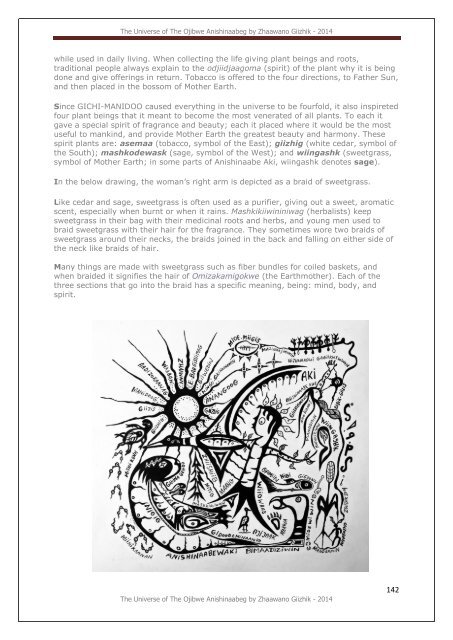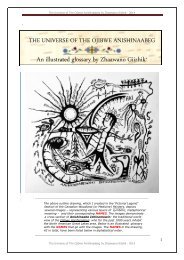The Universe Of The Ojibwe Anishinaabeg, an illustrated glossary by Zhaawano Giizhik*
A Glossary written and illustrated by Native Woodland artist Zhaawano Giizhik demonstrating a cross section of Anishinaabe Izhinamowin: the traditional worldview of the Ojibwe Anishinaabeg, who for the past 2 millennia inhabit the North American Great Lakes area.
A Glossary written and illustrated by Native Woodland artist Zhaawano Giizhik demonstrating a cross section of Anishinaabe Izhinamowin: the traditional worldview of the Ojibwe Anishinaabeg, who for the past 2 millennia inhabit the North American Great Lakes area.
You also want an ePaper? Increase the reach of your titles
YUMPU automatically turns print PDFs into web optimized ePapers that Google loves.
<strong>The</strong> <strong>Universe</strong> of <strong>The</strong> <strong>Ojibwe</strong> <strong>Anishinaabeg</strong> <strong>by</strong> Zhaaw<strong>an</strong>o Giizhik - 2014<br />
while used in daily living. When collecting the life giving pl<strong>an</strong>t beings <strong>an</strong>d roots,<br />
traditional people always explain to the odjiidjaagoma (spirit) of the pl<strong>an</strong>t why it is being<br />
done <strong>an</strong>d give offerings in return. Tobacco is offered to the four directions, to Father Sun,<br />
<strong>an</strong>d then placed in the bossom of Mother Earth.<br />
Since GICHI-MANIDOO caused everything in the universe to be fourfold, it also inspireted<br />
four pl<strong>an</strong>t beings that it me<strong>an</strong>t to become the most venerated of all pl<strong>an</strong>ts. To each it<br />
gave a special spirit of fragr<strong>an</strong>ce <strong>an</strong>d beauty; each it placed where it would be the most<br />
useful to m<strong>an</strong>kind, <strong>an</strong>d provide Mother Earth the greatest beauty <strong>an</strong>d harmony. <strong>The</strong>se<br />
spirit pl<strong>an</strong>ts are: asemaa (tobacco, symbol of the East); giizhig (white cedar, symbol of<br />
the South); mashkodewask (sage, symbol of the West); <strong>an</strong>d wiingashk (sweetgrass,<br />
symbol of Mother Earth; in some parts of Anishinaabe Aki, wiingashk denotes sage).<br />
In the below drawing, the wom<strong>an</strong>’s right arm is depicted as a braid of sweetgrass.<br />
Like cedar <strong>an</strong>d sage, sweetgrass is often used as a purifier, giving out a sweet, aromatic<br />
scent, especially when burnt or when it rains. Mashkikiiwininiwag (herbalists) keep<br />
sweetgrass in their bag with their medicinal roots <strong>an</strong>d herbs, <strong>an</strong>d young men used to<br />
braid sweetgrass with their hair for the fragr<strong>an</strong>ce. <strong>The</strong>y sometimes wore two braids of<br />
sweetgrass around their necks, the braids joined in the back <strong>an</strong>d falling on either side of<br />
the neck like braids of hair.<br />
M<strong>an</strong>y things are made with sweetgrass such as fiber bundles for coiled baskets, <strong>an</strong>d<br />
when braided it signifies the hair of Omizakamigokwe (the Earthmother). Each of the<br />
three sections that go into the braid has a specific me<strong>an</strong>ing, being: mind, body, <strong>an</strong>d<br />
spirit.<br />
<strong>The</strong> <strong>Universe</strong> of <strong>The</strong> <strong>Ojibwe</strong> <strong>Anishinaabeg</strong> <strong>by</strong> Zhaaw<strong>an</strong>o Giizhik - 2014<br />
142





